Back in October I put up an introductory post on the Charles Chauvel film Sons of Mathew. In this post I want to look at Charles Chauvel himself, one of Australia's pioneering film makers.
I have drawn the story especially from the Australian Dictionary of Biography entry on Sir Charles. Full references are provided at the end of the post.
Charles Edward Chauvel was born on 7 October 1897 at Warwick on the northern edge of the Queensland extension of the New England Tablelands. Chauvel was the second son of grazier James Allan Chauvel, and his wife Susan Isabella, daughter of Henry Barnes.
Glen Pringle records that the Chauvels were originally French but fled in 1685 to escape the bloodshed that destroyed the rest of their family during the French Revolution. I think that this is misleading since the revolution took place the following century.
It seems more likely the family were Huguenot, French Protestants, who fled France when Louis XIV Louis revoked the Edict of Nantes in 1685 and declared Protestantism to be illegal. Between 200,000 and 1,000,000 French Protestants are estimated to have fled to nearby Protestant countries at that time, many going on to the US and what would become South Africa. Chauvel is in fact recorded as an Australian Huguenot name.
The Chauvels set up home in England with several becoming officers in the Indian army and later emigrating to Australia in the late 1830s. They were pioneers on the land, initially in the Northern Rivers area of New England and later also in Southern Queensland. This pioneer period was very important to Charles Chauvel - Sons of Mathews is in part a celebration of his own family history.
Educated at Ipswich Grammar School, Charles initially worked as a jackeroo on a sheep station. In 1916 he was called home when his father, aged 53, joined the Australian Remount Unit as a lieutenant. James Chauvel served with the Australian Imperial Force in Sinai and Palestine, ending the war as a temporary major. Again, this family experience with the Australian Light Horse was to be important in Chauvel's work.
Following his father's return, Chauvel studied commercial art in Sydney and also attended drama classes. Then from 1920 he worked as a production assistant, primarily responsible for the horses, with R. L. ('Snowy') Baker and other film-makers.
Pringle records this story from Charles Chauvel's wife. Desperate to enter the movie making business, Charles begged for any job.
"Where in the world could you fit in, young man?" Snowy asked. "Horses," the determined young Queenslander replied, "you will be using horses and I know all about them and can ride."
In April 1922 Chauvel followed Baker to the United States of America. He survived in Los Angeles by writing articles about Australia and taking small jobs in Hollywood studios.
In late 1923, Chauvel returned to Australia to try to set up his own production company. With cash from friends and Queensland businessmen he produced The Moth of Moonbi (released January 1926), a romantic melodrama based upon Mabel Forrest's novel The Wild Moth. Pringle notes that Chauvel chose to use genuine bush settings in this film, something that would be a feature of many of his films.
The Moth of Moonbi was followed by Greenhide, released in November 1926. The heroine was played by Elsie May Wilcox, an actress known professionally as Elsie Sylvaney (Silveni). Chauvel had to work hard to get her to participate, but he was successful at several levels, On 5 June 1927 he and Elsa (as she became known) were married
Elsa and Charles Chauvel were to work very closely together throughout his career, sharing production and writing. Beyond the films themselves, I first came in contact with the Chauvels as a child when I was given a copy of Walkabout as a present, a book they jointly wrote.
Chauvel was an effective publicist and the first two films were modest commercial successes, although he found great difficulty in getting local distribution. Later Michael Bruxner, his first cousin on his mother's side and then Deputy NSW Premier and leader of the Country Party, would introduce legislation to try to force distributors to show Australian films, the first such legislation in Australia.
In 1928 Charles and Elsa went to the US to try to promote the two films, but arrived at the time the industry was turning to sound. Elsa did get a stage part, but they then returned to Australia where Chauvel worked first as a cinema-manager in Melbourne before settling at Stanthorpe on the Queensland extension of the New England Tablelands. The Chauvel house still exists and is now on the local tour list. 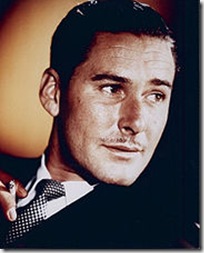
In the Wake of the Bounty (released March 1933) was Chauvel's first sound film. It was also the film that marked the start of the career of Errol Flynn (photo) who was to become one of the heartthrobs of Hollywood during the 1930s.
The film merged merged a dramatic reconstruction of the Bounty mutiny in 1789 with documentary footage of life on Pitcairn Island nearly 150 years later. To achieve this, Charles and Elsa plus a camera man spent three months on Pitcairn shooting material for the film. The end result is an odd mixture of drama and travelogue.
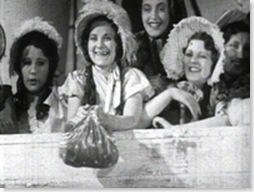 In 1935 Chauvel won the Commonwealth government's film competition with Heritage (still), a sweeping pioneer story from first European settlement to the present time. I enjoyed Heritage, although it is a somewhat clumsy film.
In 1935 Chauvel won the Commonwealth government's film competition with Heritage (still), a sweeping pioneer story from first European settlement to the present time. I enjoyed Heritage, although it is a somewhat clumsy film.
In 1936 Chauvel made a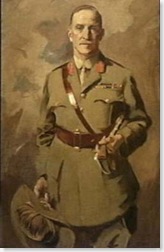 jungle adventure, Uncivilised, then visited Hollywood.
jungle adventure, Uncivilised, then visited Hollywood.
In July 1937, he began work on Forty Thousand Horsemen. Inspired by the distinguished war records in Palestine of his father, his uncle General Sir Harry Chauvel (photo) and his cousin Michael Bruxner, the film follows a group of Australian light horsemen, culminating in the cavalry charge across open ground that over-ran the Turkish positions at Beersheba.
The film was shot in around Sydney, with sand-dunes at Cronulla representing the Palestinian de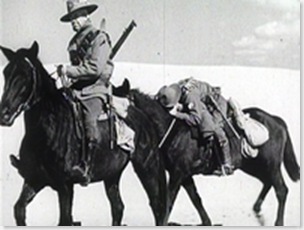 sert to considerable effect (photo).
sert to considerable effect (photo).
Released in December 1940, the film was an immediate success in Australia and overseas, helping to form popular American and British attitudes to the Australian 'digger'. Its financial success gave Chauvel a strong base for later production.
in 1944 Chauvel released another very successful war feature. The Rats of Tobruk , while also producing several short propaganda films for the Department of Information.
Rats of Tobruk was followed by Sons of Matthew (19 49), the subject of this series (still).
49), the subject of this series (still).
Produced at a cost of around £120,000, an enormous amount for the time, the film is a saga of pioneering life from a struggling farm in New England through to the rugged mountain forests of south-eastern Queensland. Filmed on remote locations under very difficult physical conditions, the film is considered by many to be his finest work.
Chauvel's final feature, Jedda (1955), was Australia's first colour feature. It was also the first to be part funded by means of a public float, with Jedda listed on the Sydney stock exchange.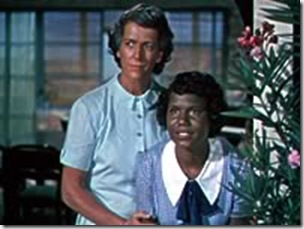
Shot largely in central and northern Australia, the film tells the story of a young Aboriginal woman torn between her own people and her white foster-parents.
Jedda was the first Australian film to feature Aborigines not just as central characters, but also to address emotional relations between them, as well as the attitudes of whites.
Following Jedda, Chauvel made thirteen half-hour films entitled Walkabout for BBC TV. Then, on 11 December 1959, he died of coronary vascular disease. He was 62
Charles Chauvel was one of the dominant figures of the Australian film industry, a man who kept making Australian films despite the small size of the local market and the overwhelming competition from imported films.
Introductory post in this series. Entry page for films about or produced in New England here
References
Don Aitkin, The Colonel : a Political Biography of Sir Michael Bruxner, Australian National University Press, Canberra, 1969.
Don Aitkin, 'Bruxner, Sir Michael Frederick (1882 - 1970)', Australian Dictionary of Biography, Volume 7, Melbourne University Press, 1979, pp 468-469. Accessed on-line edition 10 November 2008.
Australian Screen, Heritage. Accessed 10 November 2008.
Australian Screen, Jedda. Accessed 10 November 2008
Australian Screen, In the Wake of the Bounty. Accessed 10 November 2008.
Australian Screen, Sons of Mathew. Accessed 10 November 2008.
A. J. Hill, 'Chauvel, Sir Henry George (Harry) (1865 - 1945)', Australian Dictionary of Biography, Volume 7, Melbourne University Press, 1979, pp 624-628. Accessed on-line edition 10 November 2008.
A. F. Pike, 'Chauvel, Charles Edward (1897 - 1959)', Australian Dictionary of Biography, Volume 7, Melbourne University Press, 1979, pp 623-624. Accessed on-line edition 10 November 2008.
GLen Pringle, Australian Silent Star of October, 1998. Accessed 10 November 2008.
Wikipedia, Errol Flynn. Accessed 10 November 2008.
Wikipedia, Huguenot. Accessed 10 November 2008.













2 comments:
Thanks for sharing information on New England, Australia, i have visited your blog great post......
house extensions warwick qld
Post a Comment